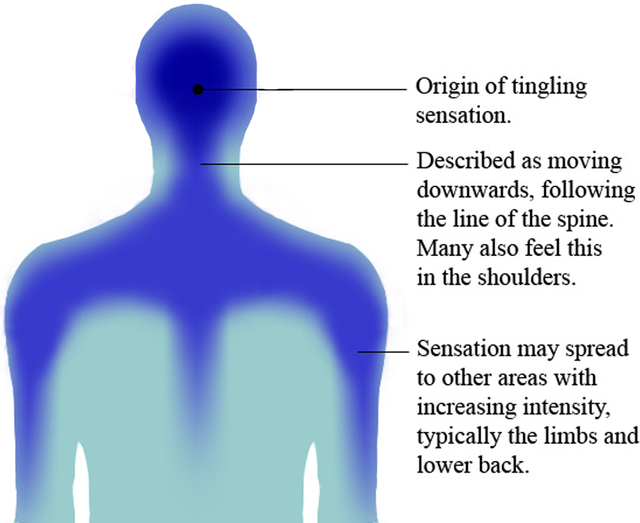
Introduction to ASMR
Autonomous Sensory Meridian Response (ASMR) refers to a tingling sensation that typically begins on the scalp and spreads to the neck and spine, producing feelings of relaxation and euphoria. Described as akin to a mild electrical current, ASMR is usually triggered by auditory stimuli like whispering, tapping, and crinkling sounds, along with visual stimuli associated with personal attention or intricate activities. The sensation has gained popularity as both a phenomenon and a form of online content, particularly through platforms like YouTube.
Early Recognition and Naming

The modern history of ASMR began in 2007, when a user named 'okaywhatever' initiated a discussion on the health forum SteadyHealth titled 'Weird Sensation Feels Good.' This thread described a tingling sensation experienced since childhood, which resonated with many others, revealing a shared phenomenon amongst participants who reported similar feelings in response to various stimuli like whispering and gentle movements[4][9].
The term 'ASMR' itself was coined in 2010 by Jennifer Allen, a participant in these discussions who sought to formalize the term to lend it legitimacy. Allen defined ASMR to signify the autonomously triggered sensory reaction distinct from sexual arousal, emphasizing its role in relaxation and comfort[5][6][9][11]. She explained that 'autonomous' reflects the individual nature of the trigger, while 'meridian' denotes a peak experience without connotations of climax associated with orgasm[6][10][11].
Growth of the Online Community

As awareness of ASMR grew, online platforms like YouTube became central hubs for both content creators (known as ASMRtists) and audiences seeking these soothing experiences. In 2009, the first ASMR-specific YouTube channel, WhisperingLife, emerged, initiating a wave of whisper videos that would lay the groundwork for the burgeoning ASMR community. By 2010, a Facebook group dedicated to ASMR, called ASMR Research & Support, was created, facilitating further discussion and community-building among those experiencing ASMR[1][3][7].
These early ASMR videos gradually attracted considerable attention, often featuring soft-spoken narration, tapping sounds, and simulated personal attention[1][6]. The community began to flourish, with ASMRtists like Maria GentleWhispering gaining large followings, eventually leading to the proliferation of diverse styles and formats[10][11].
Scientific Inquiry and Research Findings
As ASMR's popularity grew, researchers started examining its effects. The first significant peer-reviewed research published in 2015 surveyed individuals experiencing ASMR, revealing that many use it to alleviate insomnia and stress, with a high percentage reporting improved emotional well-being after watching ASMR content[8][9]. More recent studies employed fMRI technology to investigate brain activity during ASMR experiences, finding that areas associated with reward and social bonding were activated more strongly in those who experience ASMR compared to those who do not. This suggests a potential link between ASMR and social interactions, akin to the calming effects of touch and personal attention[8][10].
Societal Perception and Media Representation

While many ASMR practitioners view the phenomenon as a benign and therapeutic experience, it has not been immune to misconceptions, often being mischaracterized as sexual or fetishistic[4][5][10][11]. This misunderstanding has led to defensive attitudes within the community, as many users felt stigmatized or ridiculed for their experiences[6][9]. Despite this, media representation has evolved, with ASMR receiving mainstream attention through advertising and appearances in popular films, such as the 2017 movie Battle of the Sexes, which sought to replicate the soothing effects of ASMR in cinematic form[10][11].
The Future of ASMR
ASMR continues to evolve as a genre, now encompassing a vast array of content including relaxation videos, guided meditations, and even role-play scenarios. With millions of videos uploaded and a growing audience, ASMR has cemented its place in contemporary digital culture[10]. As scientific research progresses, there is potential for ASMR to be recognized for its therapeutic applications, especially in treating anxiety and insomnia.
In conclusion, the history of ASMR reflects a fascinating intersection of digital media, community building, and psychological research. From a niche online discussion to a burgeoning global phenomenon, ASMR illustrates how shared experiences in the digital age can lead to deeper investigations into human sensations and emotional well-being.
Get more accurate answers with Super Pandi, upload files, personalized discovery feed, save searches and contribute to the PandiPedia.
Let's look at alternatives:
- Modify the query.
- Start a new thread.
- Remove sources (if manually added).